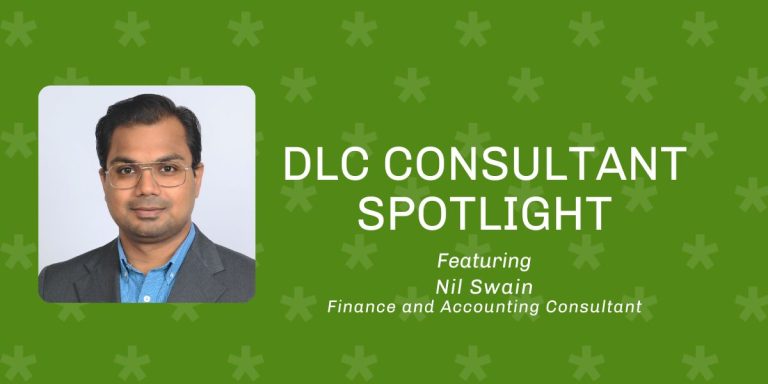Meet our DLC Finance and Accounting Consultant, Nil Swain!

Meet our Finance and Accounting Consultant, Nil Swain! Nil has been a valuable part of DLC Consulting for over 9 years. Get to know him better below!
Hometown: Bhubaneswar, India
Alma Mater: Michigan State University (MBA), National Institute of Technology (India) (B. Tech.)
Favorite things to do outside of the office: Spend time with family, reading books, cook and watching horror movies
How has your background impacted your experience as a consultant? I started my career in consulting at Accenture. Then I worked for a leading retailer as a finance manager. For the last 9+ years I have been a consultant with DLC and have worked for many clients belonging to different industries. The one thing that remains a constant is the urgency to understand the business model, agree on the exact problem statement and then make an executable plan. I am a CFA charter holder and have done my MBA in finance. Additionally, the experience I have gained from leading multiple big projects has given me the confidence to approach critical problems in an innovative way and devise a solution.
What’s a typical workday like for you? A typical day can be divided into 3 parts.
- Meetings: Attending meetings, make a list of action items with accountabilities and dates, follow up & keep stakeholders apprised
- Working sessions/workshops : Work with teams to dig deeper into functional requirements, solution architecture & financial logic
- Research/work time: Make progress on key deliverables for the client, build models and work on different scenarios/solutions that will be discussed in next workshop
As part of a team that works 100% virtually, what technology or collaboration tools do you use to make your work life easier? Microsoft Teams has been the tool of choice in my recent engagements. It’s effective in managing meetings, storing files and controlling access. Emails, IM and SharePoint have been very useful as always.
What motivates you to wake up and go to work every day? It has always been the work and the people. I get to work on different types of projects where client needs are very different. On top of that you get to partner with wonderful sets of people who bring their unique skill sets to the table to find an agreeable solution.
What kind of work have you been doing? I have been leading projects in the following areas: planning/forecasting/modelling, financial reporting, finance transformation, process reengineering/mapping and supply chain/inventory analysis. In my last engagement at a leading retail pharmacy i was managing 4 projects as a senior program manager in different domains that ranged from implementing zero-based and driver-based budgeting and cashflow consolidation to store labor planning and change control process governance.
Where do you see the benefits? The most benefits that companies are getting are from digitization, org. design changes and setting up processes with KPI monitoring. This is leading to more accuracy, timeliness & completeness of information and individual/team accountability.
Explain environments that have had lack of reporting infrastructure/inefficiencies and how have you brought organization and solutions-implementation. One of the clients, a leading insurance provider, was using legacy financial systems for their monthly reporting cycles and there were lot of issues with GL/cost center hierarchies, corporate allocations, manual overrides and hundreds of ad hoc reports. We transitioned the whole reporting suite to Adaptive Insights after recreating/cleaning all hierarchies. The new reports needed 0 manual interventions making the data trustworthy.
Most of the time we don’t have all the required information to create a complete project plan with tasks and dates. So, instead of waiting for all information to be available, the best we can do is agree on the scope, determine key stakeholders and align major milestones with rough timelines. Then we need to set up a governance call to make the plan executable and put some rhythm into it. As we move along in an agile way, we can keep on refining the plan and create prototype solutions, gather feedback and refine end product.
What’s your process? The first thing I always do is write the problem statement and get the client’s alignment. It seems obvious but is a very necessary step. This phase can be called the discovery phase, which entails asking a lot of clarifying questions and finding dependencies. Then I think of 2/3 possible solution paths that I discuss with the client in detail. After we agree on a feasible path forward, we resource the work and begin devising the solution.
Example: A leading medical device manufacture was thinking of outsourcing manufacturing offshore and close their plants. This was primarily because of rising costs and quality issues.
It was a make vs buy decision that they needed to make in a couple of months before the new financial year kicked in. My task was to provide the financial analysis and help them decide either way.The following are some of the actions that I took to make meaningful progress,
- Understand all cost components and which are geography/plant specific Vs. global
- Root cause analysis for defects
- Build financial models with break even points for each decision branch
- Include one time factors such as severance/liquidation (in case we close) Vs. training/staff augmentation/equipment upgrades (in case we keep plants open)
- Brand impact study
- Present analysis to clients
Finally, the client did not outsource the manufacturing and made some investments in equipment/technical staff and put some fail safe mechanisms/quality controls.

